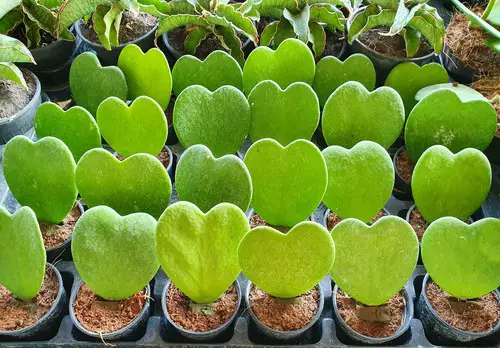Hoya heart is a popular houseplant known for its heart-shaped leaves and low maintenance requirements. However, yellowing leaves can be a common problem for hoya heart owners. If you notice your hoya heart turning yellow, it’s essential to understand the possible causes and how to fix them.
Several factors can contribute to yellowing leaves in hoya heart plants. These include improper light levels, watering, fertilizing, bad water quality, pest infestations, a lack of nutrients, or environmental temperature.
To keep your hoya heart healthy and vibrant, it’s crucial to provide the ideal growing conditions and address any issues promptly.
Key Takeaways
- Hoya heart turning yellow can be caused by various factors, including improper light levels, watering, fertilizing, bad water quality, pest infestations, a lack of nutrients, or environmental temperature.
- To prevent yellowing leaves, hoya heart plants require ideal growing conditions, including proper light levels, watering, and fertilizing.
- Addressing any issues promptly can help keep your hoya heart healthy and vibrant.
Check out these other popular posts:
Understanding Hoya Heart Plant

Hoya Heart Plant, also known as Hoya Kerrii, is a succulent plant native to Southeast Asia. It is a popular houseplant due to its heart-shaped leaves, which make it a perfect gift for Valentine’s Day or any special occasion. The plant is also known as Sweetheart Hoya or Lucky-Heart Plant.
Hoya Heart Plant is easy to care for, making it an ideal choice for beginners. It thrives in bright, indirect light and prefers well-draining soil. Overwatering can cause the plant’s leaves to turn yellow, so it’s important to let the soil dry out between waterings. In addition, the plant is drought-tolerant, so it can go for long periods without water.
Hoya Heart Plant grows slowly, and it can take several years for it to produce multiple leaves on a stem. The plant is known for holding water in its leaves, giving it drought-tolerant succulent properties. Its leaves are thick and waxy, which helps the plant retain moisture.
Ideal Conditions for Hoya Heart
Hoya Heart plants are relatively easy to care for, but they do require specific conditions to thrive. Here are some ideal conditions to ensure your Hoya Heart stays healthy and vibrant.
1. Light Requirements
Hoya Hearts require bright, indirect light to grow best. Direct sunlight can scorch the leaves, so it is best to avoid placing them in direct sunlight. If you are growing your Hoya Heart indoors, place it near a bright window that receives indirect sunlight.
If you don’t have access to natural light, you can use artificial lighting such as fluorescent bulbs to provide the necessary light.
2. Temperature Preferences
Hoya Hearts prefer temperatures between 60°F and 80°F. They can tolerate temperatures as low as 50°F, but they do not do well in temperatures below that. It is important to avoid exposing your Hoya Heart to extreme temperature changes, as this can cause the leaves to turn yellow and fall off.
3. Humidity Needs
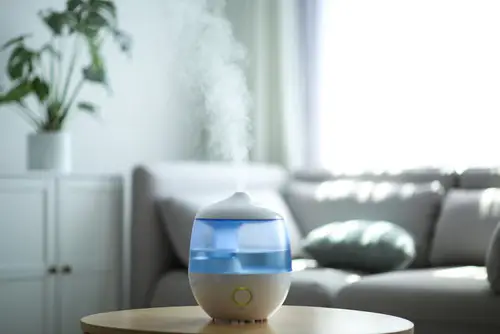
Hoya Hearts prefer high humidity levels, around 60-80%. If the air is too dry, the leaves can wilt and turn yellow. To increase humidity levels, you can use a humidifier or place a tray of water near the plant. Misting the leaves can also help increase humidity levels.
4. Soil and Potting Mix
Hoya Hearts prefer well-draining soil that is rich in organic matter. A good potting mix for Hoya Hearts should be a mix of peat moss, perlite, and vermiculite. It is important to avoid using heavy potting soil, as this can cause the roots to rot.
When repotting your Hoya Heart, make sure to use a pot that is slightly larger than the current one.
By providing your Hoya Heart with the ideal conditions, you can ensure that it stays healthy and vibrant. Keep in mind that outdoor conditions may vary, so it is important to adjust care accordingly.
Watering Hoya Heart
Proper watering is crucial for the health of a Hoya Heart plant. In this section, we will discuss the water quality, watering schedule, overwatering, and underwatering of a Hoya Heart plant.
1. Water Quality
The quality of water used for Hoya Heart plants can affect their growth and health. Tap water may contain chemicals like chlorine and fluoride, which can harm the plant. It is recommended to use distilled or filtered water for a Hoya Heart plant.
2. Watering Schedule
A Hoya Heart plant should be watered when the top inch of soil is dry to the touch. Overwatering or underwatering can cause the leaves to turn yellow. It is important to establish a watering schedule that suits the plant’s needs.
3. Overwatering
Overwatering is a common mistake made by many plant owners. It can lead to root rot and yellowing of leaves. To avoid overwatering, ensure that the pot has proper drainage, and the soil is not waterlogged.
4. Underwatering
Underwatering can also cause the leaves of a Hoya Heart plant to turn yellow. This can happen when the plant is not watered frequently enough or when the soil is too dry. It is important to water the plant regularly and ensure that the soil is moist but not waterlogged.
Fertilizing Hoya Heart
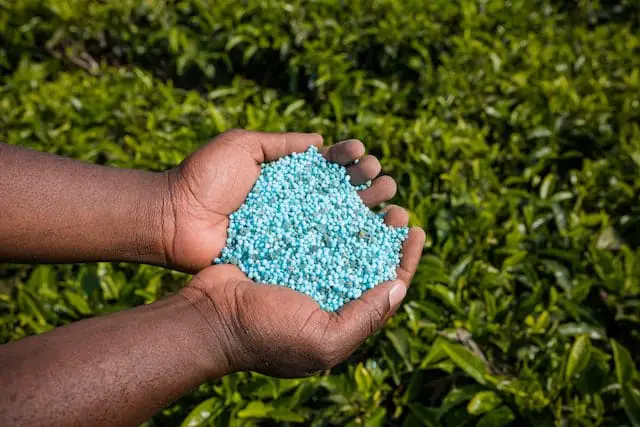
When to Fertilize
Hoya Heart plants are not heavy feeders, but they still require regular fertilization to maintain their health and to produce flowers. The best time to fertilize your Hoya Heart is during the growing season, which is typically from spring to fall. During the winter months, the plant is dormant, and it does not require as much fertilizer.
It is important not to over-fertilize your Hoya Heart, as this can cause nutrient burn and damage the plant. A general rule of thumb is to fertilize your Hoya Heart every 4-6 weeks during the growing season with a balanced liquid fertilizer.
Choosing the Right Fertilizer
When choosing a fertilizer for your Hoya Heart, it is important to select a balanced fertilizer that contains equal amounts of nitrogen, phosphorus, and potassium. Nitrogen is essential for leaf growth, phosphorus is important for flower development, and potassium helps to strengthen the plant’s roots and overall health.
There are many different types of fertilizers available, including granular, liquid, and slow-release fertilizers. Liquid fertilizers are the most popular choice for Hoya Heart plants, as they are easy to use and provide fast results.
It is also important to choose a fertilizer that is specifically formulated for indoor plants, as outdoor fertilizers can be too strong and damage your Hoya Heart. Always read the label before applying any fertilizer and follow the manufacturer’s instructions carefully.
Dealing with Yellow Leaves
Yellow leaves on a Hoya Heart plant can be an indication of stress or a problem with the plant’s environment. In this section, we will discuss the causes of yellow leaves, how to prevent them, and how to treat them if they occur.
1. Causes of Yellow Leaves
Yellow leaves on a Hoya Heart plant can be caused by a variety of factors, including:
- Overwatering: Excessive watering can cause the roots to become waterlogged, leading to yellowing leaves.
- Underwatering: If the plant is not receiving enough water, the leaves may turn yellow and dry out.
- Too much light: Hoya Heart plants prefer bright, indirect light. If they are exposed to too much direct sunlight, the leaves may turn yellow and develop sunburn.
- Low humidity: Hoya Heart plants prefer high humidity. If the air is too dry, the leaves may turn yellow and dry out.
- Nutrient deficiencies: A lack of nutrients, particularly nitrogen, can cause yellowing leaves.
- Pest infestations: Pests such as spider mites and mealybugs can cause yellowing leaves.
- Environmental stress: Environmental factors such as temperature fluctuations and drafts can cause yellowing leaves.
2. Preventing Yellow Leaves
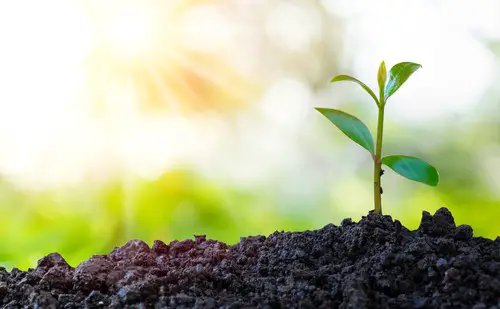
To prevent yellow leaves on a Hoya Heart plant, it is important to provide the plant with the proper care and environment. Some tips to prevent yellow leaves include:
- Watering: Water the plant when the top inch of soil feels dry, and make sure the pot has drainage holes to prevent water from accumulating in the soil.
- Light: Provide the plant with bright, indirect light, and avoid exposing it to direct sunlight.
- Humidity: Increase humidity around the plant by misting it regularly or placing a humidifier nearby.
- Nutrients: Fertilize the plant regularly with a balanced fertilizer to provide it with the necessary nutrients.
- Pest control: Inspect the plant regularly for pests and treat any infestations promptly.
- Environmental conditions: Keep the plant in a stable environment with consistent temperature and avoid exposing it to drafts.
3. Treating Yellow Leaves
If yellow leaves do occur, it is important to identify the cause and take the appropriate action. Some steps to treat yellow leaves include:
- Watering: Adjust the watering schedule to prevent over or under watering.
- Light: Move the plant to a location with less direct sunlight.
- Humidity: Increase humidity around the plant by misting it regularly or placing a humidifier nearby.
- Nutrients: Fertilize the plant with a balanced fertilizer to provide it with the necessary nutrients.
- Pest control: Treat any pest infestations promptly with an appropriate insecticide.
- Environmental conditions: Adjust the plant’s environment to provide it with a stable temperature and avoid exposing it to drafts.
Pests and Diseases in Hoya Heart
Identifying Pests
Hoya hearts are susceptible to various pests, including mealybugs, scales, and spider mites. These pests can cause the leaves to turn yellow, curl up, and fall off. If left untreated, the pests can quickly multiply and infest the entire plant.
To identify pests, check the leaves, stems, and soil for any signs of infestation. Mealybugs and scales leave a white, cottony substance on the plant, while spider mites create webbing around the leaves and stems. If there are any pests present, isolate the plant immediately to prevent the infestation from spreading to other plants.
Treating Diseases
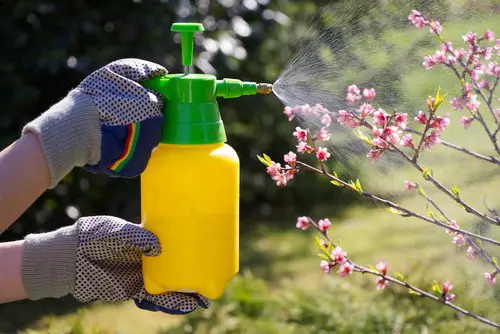
Hoya hearts are also prone to diseases, such as root rot. Root rot occurs when the soil is too moist, causing the roots to rot and decay. This can lead to yellowing leaves, wilting, and eventually death of the plant.
To treat root rot, remove the plant from the soil and inspect the roots. Cut away any dead or decaying roots and replant the plant in fresh, well-draining soil. Be sure to avoid overwatering the plant in the future to prevent root rot from reoccurring.
For pest infestations, treat the plant with neem oil or a mild soap solution. Neem oil is a natural pesticide that can kill pests on contact, while a mild soap solution can suffocate and kill the pests. Be sure to follow the instructions on the product label and treat the plant regularly until the infestation is eliminated.
Repotting Hoya Heart
When a Hoya Heart plant outgrows its current pot, it’s time to repot it. Repotting is also necessary when the soil becomes compacted and waterlogged, leading to poor drainage and yellowing leaves.
To repot a Hoya Heart plant, follow these simple steps:
- Choose a new pot that is one size larger than the current one. Make sure the new pot has drainage holes to prevent water from accumulating at the bottom.
- Prepare the potting soil. Hoya Heart plants prefer loose, well-draining soil. A good potting mix for Hoya Heart includes peat moss, perlite, and coarse sand.
- Remove the plant from its current pot. Gently loosen the soil around the roots, being careful not to damage them.
- Place a layer of fresh potting soil at the bottom of the new pot.
- Position the plant in the new pot, making sure the top of the root ball is level with the rim of the pot.
- Fill the pot with potting soil, pressing down gently to eliminate any air pockets.
- Water the plant thoroughly, allowing excess water to drain out of the bottom of the pot.
- Place the plant in a bright, indirect light location and avoid direct sunlight for a few days.
Repotting a Hoya Heart plant can help prevent yellowing leaves caused by poor drainage and compacted soil. By following these steps, you can ensure that your Hoya Heart plant has the proper potting soil and drainage it needs to thrive.
Propagation of Hoya Heart

Hoya Hearts are easy to propagate through leaf cuttings. The best time to take cuttings is during active growth in the spring. It’s important to wait until the plant has started to develop new shoots and leaves, so the cuttings have the best chances of propagation.
When selecting a cutting, look for healthy green growth that can be snipped off. Avoid using withered stems or leaves that are yellow or brown as they won’t propagate well. Use a clean, sharp pair of scissors to take a cutting, making sure it’s at least 2-3 inches long with a few leaves attached.
After taking the cutting, remove any leaves from the bottom inch of the stem, leaving at least two leaves at the top. Dip the cut end of the stem into rooting hormone powder to encourage root growth. Then, plant the cutting in a small pot filled with well-draining soil.
Water the cutting lightly and place it in a bright, warm spot with indirect sunlight. Avoid direct sunlight that can scorch the leaves or too much shade that can prevent growth. Keep the soil moist but not waterlogged to prevent root rot.
In about 4-6 weeks, the cutting should start developing roots and new growth. Once it has established roots, it can be transferred to a larger pot with the same type of soil mix.
Propagation of Hoya Hearts is an easy and rewarding process that allows you to expand your collection of these beautiful plants. With proper care and attention, your new plant will thrive and produce stunning heart-shaped leaves.
Varieties of Hoya Heart
Hoya Heart is a popular houseplant that comes in many varieties. Each variety has unique characteristics, making it a favorite among collectors. Here are some of the most popular varieties of Hoya Heart:
1. Variegated Hoya Heart
Variegated Hoya Heart is a stunning variety that features leaves with white or yellow edges. The variegation can be random or in patterns, giving the plant a unique and beautiful appearance. This variety requires bright, indirect light and well-draining soil to thrive.
2. Reverse Variegata Hoya Heart
Reverse Variegata Hoya Heart is a rare variety that features leaves with green edges and white or yellow centers. The reverse variegation gives the plant a striking appearance that is sure to catch the eye. This variety requires bright, indirect light and well-draining soil to thrive.
3. Splash Hoya Heart
Splash Hoya Heart is a unique variety that features leaves with random splashes of white or yellow. The splashes can be small or large, giving the plant a playful and fun appearance. This variety requires bright, indirect light and well-draining soil to thrive.
Common Problems and Solutions
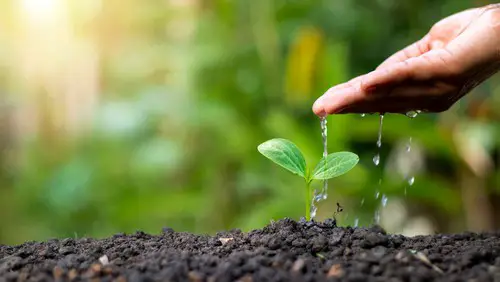
Hoya heart plants are popular for their heart-shaped leaves and ease of care. However, they can develop yellowing leaves, which is a sign of an underlying problem. In this section, we will discuss some of the common problems that cause hoya heart plants to turn yellow and their solutions.
1. Improper Environmental Temperatures
Hoya heart plants do not like cool temperatures or drafts. Drafts can dry foliage causing it to be yellow. Hoya heart plants should not be placed in locations with temperatures below 50°F. Colder temps stress this succulent and can cause yellowing foliage.
Solution: Ensure that the hoya heart plant is placed in a location with consistent temperatures between 60-85°F. Avoid placing it near drafts or air conditioning vents.
2. Improper Watering
Overwatering or underwatering can cause hoya heart plants to turn yellow. Overwatering can lead to root rot, while underwatering can cause the plant to wilt and dry out.
Solution: Water the hoya heart plant once every two weeks, or when the soil is bone dry. Ensure that the pot has drainage holes to prevent water from accumulating at the bottom.
3. Low Humidity
Hoya heart plants prefer high humidity levels, and low humidity can cause the leaves to turn yellow and wilt.
Solution: Use a humidifier or place a tray of water near the plant to increase humidity levels.
4. Lack of Oxygen
Hoya heart plants require oxygen to thrive, and if the soil is compacted, it can lead to a lack of oxygen and yellowing leaves.
Solution: Ensure that the soil is loose and well-draining to allow for proper oxygenation.
5. Wrinkled Leaves
Wrinkled leaves are a sign of dehydration and can cause the leaves to turn yellow.
Solution: Water the hoya heart plant when the soil is bone dry, and mist the leaves regularly to increase humidity levels.
Frequently Asked Questions
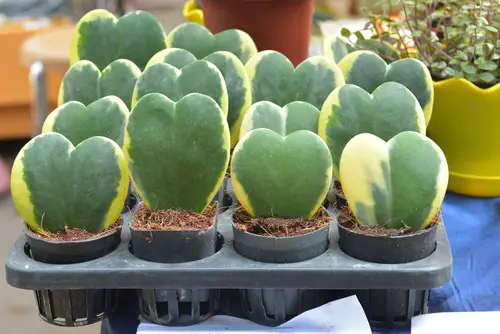
How do I save my Hoya plant from turning yellow?
If your Hoya plant is turning yellow, it’s crucial to identify the underlying cause before attempting to save it. Common reasons for yellowing include overwatering, underwatering, insufficient light, and pest infestations.
To save your Hoya plant, you should address the root cause of the yellowing and adjust your care routine accordingly. For example, if you’re overwatering your plant, you should reduce the frequency of watering and ensure that the soil is well-draining.
If your plant is not getting enough light, you should move it to a brighter location.
What are the signs of an overwatered Hoya plant?
Overwatering is a common cause of yellowing in Hoya plants. Signs of overwatering include yellowing leaves that are soft and mushy to the touch, as well as soil that is consistently wet.
To prevent overwatering, ensure that your Hoya plant is planted in well-draining soil and that the pot has drainage holes. Water only when the top inch of soil is dry to the touch.
Why are my Hoya leaves turning yellow and falling off?
Yellowing and falling leaves in Hoya plants can be caused by a variety of factors, including overwatering, underwatering, pests, and disease. It’s essential to identify the root cause of the yellowing before attempting to fix the issue.
For example, if your Hoya plant is infested with pests, you should treat it with an appropriate insecticide. If your plant is not getting enough light, you should move it to a brighter location.
What causes Hoya leaves to turn light green?
Hoya leaves can turn light green due to a lack of sunlight. Hoya plants require bright, indirect light to thrive. If your plant is not getting enough light, you should move it to a brighter location.
However, it’s important to avoid exposing your Hoya plant to direct sunlight, as this can scorch the leaves.
Why is my Hindu rope plant turning yellow?
Hindu rope plants, also known as Hoya carnosa compacta, can turn yellow due to a variety of factors, including overwatering, underwatering, insufficient light, and pest infestations.
To prevent yellowing in your Hindu rope plant, ensure that it’s planted in well-draining soil and that the pot has drainage holes. Water only when the top inch of soil is dry to the touch, and ensure that your plant is getting enough bright, indirect light.
What is the yellow fungus on Hoya plants?
Yellow fungus on Hoya plants is a fungal infection that can cause yellow spots on the leaves. It’s essential to remove any infected leaves and treat the plant with an appropriate fungicide to prevent the infection from spreading.
To prevent fungal infections, ensure that your Hoya plant is planted in well-draining soil and that the pot has drainage holes. Avoid overwatering and ensure that your plant is getting enough bright, indirect light.

Hey, I’m Lisa and I’ve been an avid gardener for over 30 years. I love writing, talking and living in the garden! Feel free to connect with me on my socials below

